Top News
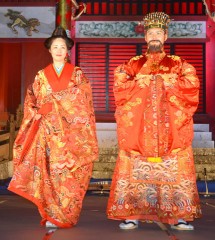
September 8, 2014 Ryukyu Shimpo
A selection ceremony for a new “king” and “queen” took place at the event “Mid-Autumn Feast” held in the Una forecourt of Shurijo Castle in Naha on September 7. Twenty-year-old company employee Daichi Teruya was chosen in the role of “king” and 25-year-old nursing teacher Marina Oyama as “queen.” Their first jobs will be to attend a swearing-in ceremony on November 1 in which the Sapposhi or envoy of the Chinese Emperor will bestow the imperial seal on the new King of Ryukyu, followed by a parade in the Una forecourt. The new “king” and “queen” will take part in events hosted by Shurijo Castle Park over the next twelve months. The selection event had 14 applicants for king and 29 for queen.
Wearing a brightly-colored crown, the new “king” Teruya said, smiling, “I am surprised and delighted.” He went on to say, “I want to convey our unique culture and history to people all around the world.”
Dressed in showy costume, Oyama said in tears, “I am so happy.” She continued, “I would like children to know the queen of the time-honored Ryukyu Kingdom. I will do my best to continue this tradition.”
Before the event, the kumiodori play Nidou tekiuchi and other plays were performed. The spectators enjoyed a fantastic evening.
(English translation by T&CT)
Go to Japanese
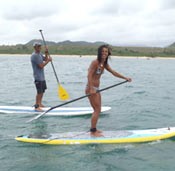
September 8, 2014 Ryukyu Shimpo
Stand up paddle boarding (SUP), in which boarders paddle standing up, is becoming a popular sport in Okinawa. On September 1, the Yaemaya SUP Association was set up in Ishigaki City, with the aim to promote the sport in Okinawa. On the same day, people involved with the association held an organization meeting and press conference at Ishigaki Port Rito Terminal.
The number of SUP lovers and businesspeople related to the sport is increasing in the Yaeyama region. The association was established to prevent accidents from occurring and further promote the sport.
It plans to hold training sessions and competitions, and train instructors. It will promote SUP as a new marine sport in Okinawan tourism, and try to attract more members.
According to the association, the Hawaii-born sport is getting popular in Japan. However, there have been accidents involving loss of life.
The head of the association Chikara Tsuyama who is a president of Island Club Co., said, “Although SUP is an easy sport to learn, there is a possibility boarders could be swept out to sea almost before they realize it.” He went on to say, “As the number of people practicing the sport increases, we need to work on preventive measures.” Tsuyama added, “The association can contribute to promoting Okinawan tourism by providing high quality SUP services.”
(English translation by T&CT)
Go to Japanese
September 3, 2014 Ryukyu Shimpo
The Shimakutuba Liaison Council has made a petition to the Okinawa Prefectural Assembly seeking to enact a regulation on the protection of local languages. The liaison council wants to restore and inherit rights to protect Shimakutuba or Ryukyuan languages. The purpose of the petition is to stipulate rules on the spreading and teaching of Shimakutuba in school education. Introducing Shimakutuba into school education is essential to pass on it to the next generations. We want to give our full assent to the petition.
UNESCO (United Nations Educational, Scientific and Cultural Organization) announced in 2009 that 2,500 of about 6,000 languages in the world were at risk of disappearing forever. Six Ryukyuan languages are listed in the Unesco’s Atlas of the World’s Languages in Danger of Disappearing. We should take this situation seriously.
The Okinawa Prefectural Government (OPG) carried out the Okinawan People’s Awareness Survey on Shimakutuba last year. According to the survey, around 80 percent of the residents have a sense of familiarity with Shimakutuba, and a desire to pass on it to the next generations. However, the rate of residents who mainly use Shimakutuba or use it as much as Japanese remained 35.4 percent of all residents. There are many people who want to use it, but they cannot use it because they do not have the opportunity to learn it. The results of the survey suggest it is beyond question that the educational initiative for Shimakutuba is needed.
The Okinawa Prefectural Assembly enacted a regulation drafted by local government to promote Shimakutuba and set up Shimakutuba Day, to be held every September 18 in 2006. The OPG made the Shimakutuba promotion plan after it held the Okinawan people’s Shimakutoba promotion rally for the first time last year. In this plan, the OPG warns that the annihilation of Shimakutuba would lead to a weakening of love for and pride in our hometown, and the decline of the Okinawa culture as a result.
However, the OPG has a cautious attitude towards introducing Ryukyuan language into school education programs, saying that it requires more consideration in line with the national government’s curriculum guidelines. We do not understand why the OPG hesitates to introduce Shimakutuba into public education despite asserting the disappearance of Shimakutuba will lead to the decline of the Okinawan culture.
Nakagusuku village has begun teaching the History of Ryukyu at its elementary schools from this year as part of its own education program. The OPG should think hard about this issue.
A native Hawaiian educational organization was founded in 1983 in Hawaii. Elementary, middle and high schools conducting lessons in Hawaiian language emerged. As a result, the number of people 70 years of age or younger who speak Hawaiian has increased to more than 2,000 people. Less than 50 people spoke Hawaiian in 1982. The Shimakutuba Liaison Council has suggested in its petition a plan to set up the Shimakutuba Education Center in order to train teachers systematically and develop teaching materials. We strongly recommend the OPG set up the center and start lessons in Shimakutuba in schools as soon as possible in order to regain our language as a foundation of culture and to develop Okinawan culture.
(English translation by T&CT)
Go to Japanese
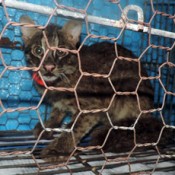
September 9, 2014 Ryukyu Shimpo
An Iriomote wild cat, classified as Critically Endangered by the International Union for the Conservation of Nature, was injured in a traffic accident on Iriomote Island in August. The Iriomote Wildlife Conservation Center of the Ministry of the Environment, which had been taking care of the cat, released it into the forest when it recovered from injuries on the evening of September 3.
This is the first time an Iriomote wild cat has been released into the wild after a traffic accident.
The released cat is a five-month old female.
A college student passing by found the cat lying still in the middle of the prefectural road on August 26.
After being notified, the Wildlife Conservation Center sheltered the cat. She had a scrape on her forehead. The cat’s pupils looked odd. The center determined that the cat had been hit by a car because it had suffered injuries to the head.
The cat received medical treatment from the center, and recovered well. The center attached a collar with a transmitter onto the cat, and released her into the forest close to where she was found.
Makoto Fukuda,a conservation ranger at the center said, “It was fortunate the cat received medical treatment quickly. We would like people who find Iriomote wild cats or hit them while driving to always tell us.” He went on to say, “We would like people to drive safely with great caution, especially during evening hours on Iriomote Island.”
(English translation by T&CT)
Go to Japanese
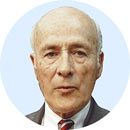
September 1, 2014 Ryota Shimabukuro of Ryukyu Shimpo reports from Washington D.C.
Former US Assistant Secretary of Defense Joseph Nye suggested in his article posted to the Huffington Post on August 7 that “many Japanese still resent the lack of symmetry in the alliance obligations. Others chafe at the burden of U.S. bases, particularly on the island of Okinawa.” He pointed out, “As China invests in advanced ballistic missiles, the fixed bases on Okinawa become increasingly vulnerable.” Joseph Nye is one of the most influential foreign policy thinkers on Japan policy in the U.S. Democratic Party.
The governments of Japan and the United States have asserted Okinawa’s strategic location as a reason to concentrate US forces on the islands. However, Nye suggests that so-called geographical advantage of Okinawa is lost.
The former US Assistant Secretary of Defense emphasized, “The U.S. and Japan must rethink the structure of their alliance.” However, referring to the future alliance between Japan and the United States, Nye said, “Abe’s modest step toward collective self-defense is a step in the right direction.” He pointed out, referring to the US forces in Japan, “A longer-term goal should thus be for the U.S. gradually to transfer its bases to Japanese control, leaving American forces to rotate among them.” At the same time, he said that the process must be handled carefully.
He stressed, “To avoid the perception that the U.S. decided to turn the bases over to Japan just when their military benefits were diminishing, and to ensure that the move represented America’s recommitment to the alliance, a joint commission would have to be established to manage the transfer.”
Nye supported the United States Government’s policy to move the U.S. Marine Corps to Australia in his article posted in the opinion pages of The New York Times web site on November 21, 2011. He pointed out “The current official plan to move the Marines inside Okinawa is unlikely to be acceptable to the Okinawa people.”
(English translation by T&CT)
Go to Japanese
September 1, 2014 Ryukyu Shimpo
The Okinawan Peoples’ Action Committee will hold a rally to protest the building of a US air base for replacement of the Futenma base. The event will take place at 2 p.m. on September 20 at the beach near Henoko Fishery Port. The organizer wants more than 2,000 people to take part in the rally. On August 23, the protest rally was held in front of Camp Schwab in Henoko. The committee consists of civil peace groups, opposition lawmakers from Okinawa and members of the Okinawa Prefectural Assembly.
On August 23, there were not enough chartered buses to carry all the people who wanted to go to the protest. The committee will increase the number of available buses this time.
Staff members of the committee are also considering holding a rally of 10,000 people at 21st Century Forest Park in Nago in mid-October.
(English translation by T&CT)
Go to Japanese

September 3, 2014 Ryukyu Shimpo
On September 3, the Okinawa prefectural assembly held a special meeting and passed a resolution of protest against the seabed drilling survey being carried out for construction of a new base, which is part of a relocation of the U.S. Marine Corps Futenma Air Station in Henoko, Nago City. The statement requesting an immediate cessation of the construction work was passed with 26 in approval and 14 in opposition. The assembly members from four opposition parties of Social Democratic Pro-Constitution, Kenmin Network, Japanese Communist Party, Social Mass Party, and ruling party Komei Party independent members gave their approval. The Liberal Democratic Party members opposed it. Three members of Souzou Party and independent Yasuhiro Arakaki walked out.
Regarding the Abe administration’s commencement of the seabed survey, the statement said, “The government has trampled democracy and peoples’ dignity. We will not tolerate it. With anger, we condemn such tyranny.” Then, the statement demanded:1) to immediately stop the building of a new base in Henoko including the seabed drilling survey, 2) to immediately stop excess security and suppression of the protest movement, 3) to remove the iron grid set up in front of Camp Schwab Gate 1, as well as the buoys and floats in the sea.
(English translation by T&CT and Megumi Chibana)
Go to Japanese
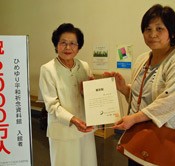
August 24, 2014 Ryukyu Shimpo
On August 23, the Himeyuri Peace Museum welcomed its 20 millionth visitor since it opened in June 1989 in Itoman. Sayuri Watanabe, from Aichi Prefecture, who for the first time visited the museum, became the 20 millionth visitor. At the welcome ceremony, the curator of the museum Yoshiko Shimabukuro said, “We hope to convey to you thoughts of peace.”
Watanabe received a certificate and commemorative gift from the museum. She said, “It was my honor. I want to share what I saw in the museum with people in my hometown.”
“The museum has reached the milestone of its 25th year anniversary,” the curator said. “We did not imagine that the museum would have so many visitors when it opened. We now have to worry about an increasing number of younger people who do not know about the war. We want to convey the misery of war to them as many as possible in order to protect the peace.”
(English translation by T&CT, Hitomi Shinzato)
Go to Japanese
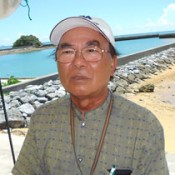
August 28, 2014 Yugo Okita of Ryukyu Shimpo
“Henoko and Oura Bay are the only remaining rich fishing grounds on the east coast of Okinawa. If we just sit by and watch the reclamation, the fishing industry of Okinawa will not survive long.” The self-proclaimed “Chief of the Fish Market”, former Okinawa Prefecture Fishery Cooperative president Jinsho Nishime, voiced his opposition to the land reclamation in Henoko being carried out for the relocation of Futenma Air Station.
Nishime was not originally a fisherman, but he played a part in founding the Iheya Village Fishery Cooperative. Nishime became its first president at the age of 32, and has been involved in managing the cooperative ever since. “No one can live an abundant life with just subsidies that are unearned income. Self-reliance for fisherman is connected to such abundance.” That was his philosophy when he managed and cultivated mozuku, helping it become Iheya’s representative local product.
From 2002 to 2008, he was the president of the Okinawa Prefectural Fishery Credit Cooperative, and between 2003 and 2006 he was simultaneously the president of the Okinawa Prefecture Fishery Cooperative . As president of the prefectural fishery cooperative, he faced problems related to adverse effects of the U.S. military on the fishing industry. These were red soil runoff from the construction of an urban training facility in Camp Hansen in Kin and the crashing of an American F-15 fighter jet in training airspace in the northeast of Ikei Island in Uruma. He said, “Okinawa’s seas, skies, and land are being used by the U.S. military as if it were their own, and the Japanese government accepts that. Regardless of ideology or beliefs, anyone who puts some thought into this will find this situation ridiculous.”
He made multiple visits to the then-Naha Defense Facility Bureau and the Okinawa office of the Ministry of Foreign Affairs protesting the accidents and requesting a suspension of training activities. However, the situation did not change. He said he realized that, “The training the U.S. military carries out is in preparation for war, which is not in the interests of the civilians who want to live in peace. These two cannot coexist.”
In the spring of 2005, he visited Teima Fishing Harbor in Nago to listen to the people directly. After listening to the fishermen who swelled with pride as they recalled bringing up their children on the bounty of Oura Bay, his conviction the sea must not be lost became stronger.
He believes there are present fishermen who are against them building of the military base. “Because of their obligations, there are many people who cannot voice their opinions. However, staying silent will bring about resentment in future. Speaking out is essential so we do not leave our children and grandchildren with a negative legacy,” he said, hoping the fishermen will voice their protests too.
(English translation by T&CT and Lima Tokumori)
Go to Japanese
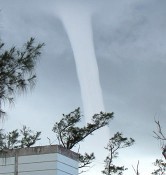
September 1, 2014 Ryukyu Shimpo
Around 9:30 p.m. on August 31, a tornado appeared over Oura Bay in Nago.
There were no reported injuries or damages property around the bay.
Yoshiharu Nina who lives in the Teira district, confirmed the occurrence of a tornado. He said the tornado moved from the coast off Camp Schwab to Oura Bay, and disappeared around Sedake.
Nina was surprised to say, “Although I had heard there had been tornadoes over the sea, this was the first time that I actually watched it.”
According to the Okinawa Meteorological Observatory, a rapidly developed cumulonimbus cloud covered the sky over Oura Bay when the tornado appeared over the bay. In August, a tornado also appeared over Shimoji Island.
(English translation by T&CT)
Go to Japanese
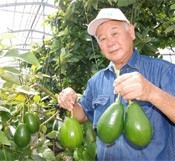
September 1, 2014 Ryukyu Shimpo
Koei Kinjo, a farmer in the Yoza district of Itoman City, is one of few in Okinawa cultivating avocado. Producing the fruit since 2010, Kinjo succeeded in growing green and shiny avocados in clusters in a plastic greenhouse this summer. Kinjo said, “I would like to ship my avocados as specialty goods outside of Okinawa.”
He cultivates the fruit in a plastic greenhouse as well as outdoors. While the avocados cultivated outdoors were damaged by typhoon, those cultivated in a plastic greenhouse are steadily growing. Seven avocado trees have produced over 100 fruits.
After being impressed by avocado cultivation in Yaeyama four years ago, Kinjo decided to grow the fruit in Itoman.
To shorten the growth period, he cultivated avocados by grafting. The trees quickly grew and started producing fruits.
Kinjo said, “I don’t need to use agricultural chemicals because the fruit does not attract insects. It is easy to cultivate.”
Kijo said that avocado was cultivated in Hokkaido too, but that Okinawa could also become a major producer of the fruit. He claimed, “Okinawa should lead the avocado market as a major producer of tropical fruits in Japan. I am sure that Okinawa-grown avocado will get popular as a high-class food. By increasing the number of avocado farmers, I would like to make this fruit a specialty product of Okinawa.”
Kinjo recommended a recipe for a drink, which is a mix of avocado, milk and honey, and brandy in a blender. “One of my friends from Brazil taught me the recipe. It is delicious.” Kinjo intends to sell his avocados to a farmer’s market in Itoman this September. He said proudly, “I would like people to taste the fresh and soft avocados that I produced.”
(English translation by T&CT)
Go to Japanese









 Webcam(Kokusai Street)
Webcam(Kokusai Street)


